Take a walk on the wild side.
This self guided walk takes us around two busy and very central areas of London, Soho and Covent Garden, with so many stories to tell. Considering Soho’s reputation, we can even call it a Walk on the wild side – just to quote the famous Lou Reed Song. Soho has been for centuries an area with a bad reputation, where illegal or barely legal activities always proliferated. Prostitution, gambling, night clubs have found a fertile soil in this part of London, although, when it was originally designed in 1600 it was meant to become an elegant residential district for the noble Londoners, like the nearby Bloomsbury. But the story was very different.
A short history of Soho:
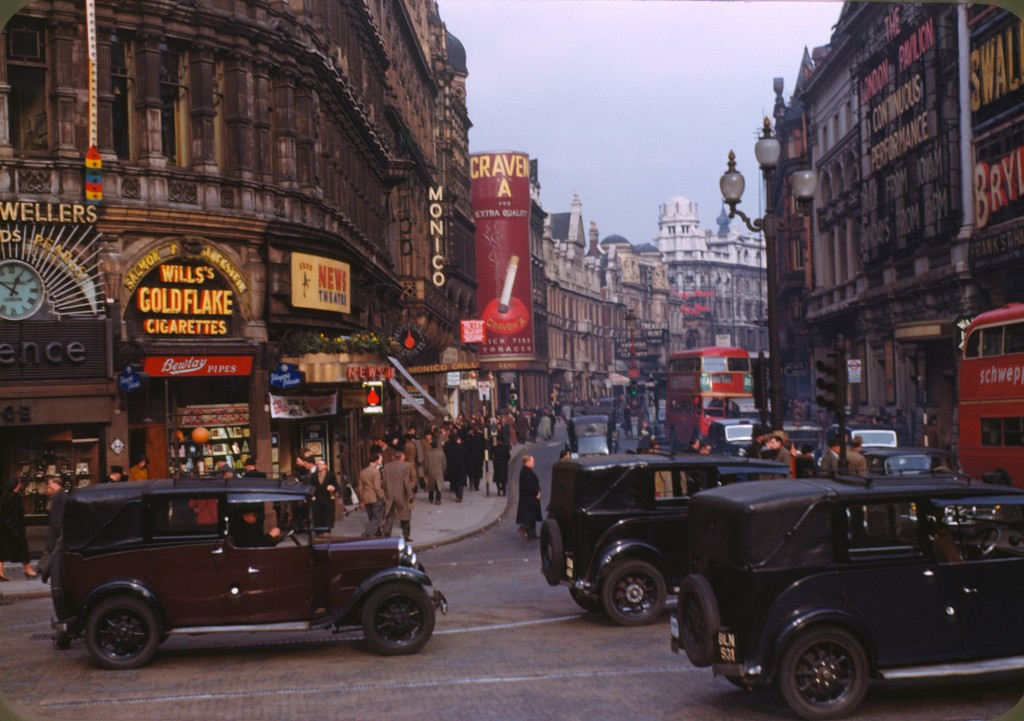
Until 1600 Soho was little more than fields and meadows: an area where hunting was still practiced (and so-ho was just a cry of hunting ), but after the terrible fire of London in 1666 the city began to expand westward looking for more space than the cramped streets of the City, a place where they could build bigger, safer and more comfortable houses. The noblemen were already building new residential areas, such as Bloomsbury and Covent Garden , and Soho ideally would have to undergo the same transformation. But towards the end of the ‘ 600 the early immigrations from Europe had attracted foreigners in this area: the first were the French Protestants – the Huguenotes , fleeing persecution. They were so many that Soho was considered a real French quarter. The English nobles did not like very much these intrusions from the outside, and gradually abandoned all their properties, which were mainly located around Soho Square. Little by little the properties abandoned by the nobles became in the 18th century the refuge for new immigrants. The area became overcrowded, with many people living in little flats, and in the second half of ‘800 were not uncommon cases of cholera. At the end of the nineteenth century immigration from Italy and Greece brought also the opening of small restaurants, which attracted a clientele of intellectuals in search of fun and cheap food and large drinks. The pubs obviously prospered and with them the small theaters and other less elegant distractions. At the beginning of the twentieth century London’s Soho was the equivalent of Montmartre in Paris.
In the 40s and 50s Soho began to attract a new form of entertainment: jazz music. Small jazz clubs and other music venues were multiplying and artists preferred to live in the area. From jazz to rock and the beat generation, in the 50s and 60s Soho became the centre of the music scene. Local venues such as the Flamingo Club, Ronnie Scott and the Marquee began to establish themselves as the leading stage of the new music scene: these were the places where the likes of the Beatles, the Rolling Stones, Jimi Hendrix, Eric Clapton and many more music legends moved their first steps . Traces of this past are still present in every corner. Let’s go and find them out with our walk in Soho and Covent Garden.
From Piccadilly Circus to Covent Garden.
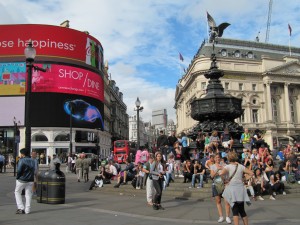
We start our walk in the most colorful and busy square of London: Piccadilly Circus, which also marks the southwesterner limit of Soho.
Did you know?
- Coca – Cola has sign in Piccadilly Circus since 1954.
- The fountain, commonly called Eros , is actually dedicated to his brother Anteros, the Greek god of requited love, chosen as an example of the philanthropic generosity of Lord Shaftesbury, to whom the fountain is dedicated.
We begin to move towards Leicester Square, leaving behind us the statue of Eros (or Anteros, to be precise). Geographically Leicester Square is located outside of Soho, but it reflects the same characteristics and shares its history. The square was designed in 1670 as a residential neighborhood, but gradually lost this characteristic, taking on a more commercial one. At the centre of the square is a statue of William Shakespeare and on the south side we can see the kiosk where you can buy discounted theatre tickets. If you have not yet made plans for the evening, it may be worth checking if there cheap tickets on offer for a musical or a play! All around the square we can see several cinemas, and it is not uncommon to see the red carpet in front of the entrances of the Empire or Odeon cinemas, waiting for the arrival of the stars for a film premiere. The Empire cinema is at the point where the old Empire Theatre was, closed since 1927. Also the Odeon Cinema is located on the site of another famous venue of the late nineteenth century, the Alhambra.

We go straight towards Leicester Square underground station and we come across Charing Cross Road. We turn right taking preferably the left side of the road, until we reach Cecil Court, on our left . We walk along Cecil Court, and if you are fond of books and antiques you cannot avoid stopping to look at some of the shop; at the end of the lane turn right onto St. Martin ‘s Lane. This was once the main road leading north from Whitehall. In St. Martin ‘s Lane, on the left side, we can see the Coliseum, the largest theatre in London. A little further, on the left, you will find a narrow alley, probably the narrowest street in London: Brydges Place. We take this narrow passage, hoping that no other party is coming towards us from the opposite direction, otherwise we will have to squeeze against the wall to let them pass! At the end of the alley, on the right you will see the Marquis pub, already famous in 1600 for having among its clients the famous Claude Duval, a fearsome thief / gentleman, who was eventually captured in this pub: it is not always a good idea to visit the pub when you are wanted! Now he lies buried in the church of Covent Garden, not far from here.
Did you know?
On Duval’s grave there is a curious epitaph:
Here lies Du Vall:
Reader, if male thou art,
Look to thy purse;
If female, to thy heart.
A real heart-throb, our Duval!
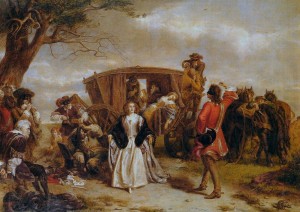
We continue straight on Chandos Place and then on Maiden Lane; here , at the back of the Adelhpi theatre, we can see a royal coat of arms above a door, just before the stage door: it was from this door that Queen Victoria accessed the theatre to avoid the crowds at the main entrance. Continuing on Maiden Lane we get to Southampton Street, where we turn left and arrive at Covent Garden.
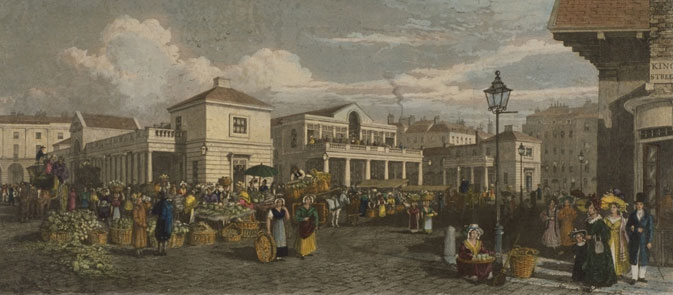
From Covent Garden to Seven Dials.
Did you know? Covent Garden was once called Convent Garden , because originally this was the area where fruit and vegetables were grown for the monks of Westminster.
Here we can get lost among the stalls and shops that fill this lively square, or we can look at the jugglers performing in front of the church of St. Paul. This church is also known as the Church of the actors , because of its proximity to many theatres and its walls are covered with dedications in memory of famous actors of the past. The church is the only original building of Covent Garden and was built in 1633
If we turn around the market square we come to Russel Street and turning left to Bow Street. Here , on the left , you can see the Royal Opera House, and on the right the building that housed the first police station in London, in 1829. Next to it is the old and now unused Bow Street Magistrates’ Court, where celebrities such as Oscar Wilde, or the famous East End twin criminals, the Krays, were trialed.
Did you know? London policemen are called Bobbies, because the police force had been introduced in 1829 by Sir Robert Peel. They were either called Bobbies or Peelers, but Bobbies remained the most common nick name.
Turn left on Floral Street and then right towards the underground station. We cross the road and proceed onto Neal Street. Go across Shelton Street and continue on Neal Street until you reach the the intersection with Shorts Gardens; turn left and then immediately right into the narrow passage indicated as “Neal’s Yard”. After the narrow passage we come out in the colourful square of Neal’s Yard, one of the most beautiful in the area. Leave the square – after the customary pictures: how can you miss a view like this in your memory book! – go through the passage on the opposite side of the square and turn left on Monmouth Street, then go straight until you get to the roundabout called Seven Dials. Today is a lively crossroads bordered with shops and restaurants, and no one would think that Seven Dials in the nineteenth century was one of the most dangerous roads of London. It was virtually impossible to wander around here at night without suffering a robbery or an assault, so that even the police kept well away. The pub on the corner – the Crown – has long been witness to this past. A good excuse to pop in, try a local beer and watch the pictures on the walls that tell the story of Seven Dials.
From Seven Dials to Piccadilly.
We continue our walk through the streets of Soho following Monmouth Street to West Street, where we turn right in front of the St. Martin ‘s Theatre. There is no need to control what’s on: it is surely Agatha Christie’s The Mousetrap , which has now beaten every possible record of performances: more than 25,000, staged continuously for over 60 years!
We continue on Litchfield Street past the Ivy, one of those absurd places in London where you have to apply for a special permit to enter, and ask for a mortgage to pay the restaurant bill. But it is a historical place all the same, which has been opened for almost a century and has seen the most famous actors. But we are not famous actors, so we can just carry on. At the end of the road we turn right on Charing Cross Road and we arrive at Cambridge Circus. Here we find the beautiful Palace Theatre.
Did you know? The foundation stone of the Palace Theater, build in 1888, is still visible in the lower right part of the building, near the entrance.
We leave the theatre on our right and we take Shaftesbury Avenue, then we turn left at Gerrard Place and enter Chinatown. Turn right in the pedestrianized Gerrard Street, the heart of Chinatown. Here you can browse around the shops for Chinese food and look at the various and mysterious (being written in Chinese) specialties, at the clinics specialised in oriental medicine and treatments and, of course, restaurants.
Did you know? This part of London has become Chinatown only recently, more or less since the early 50’s. After the war there was a growing interest on oriental cuisine, especially after the return of the soldiers from the Far East. For the local Chinese community – initially located in the East End of London – Gerrard Street seemd to be the perfect location to start this business, being an area of Soho where foreign restaurants were already successful. Today, about 120,000 Chinese reside in London and this has become the heart of their community.
At the end of Gerrard Street turn right onto Wardour Street and then right again on Shaftesbury Avenue, then turn left onto Dean Street. Continue until you reach Old Compton Street, on the right, then turn left into Frith Street . Here on the right we see an institution of Soho, Bar Italia , one of De Niro’s favourite bars when in he’s in town. If you need a shot of caffeine to continue your tour, it’s the right place to do it!
Just after bar Italia, if you look up you can see a blue plaque that shows the house where Mozart lived for a couple of years during his childhood. Around Soho we will see more of these blue plaques that identify places with historical relevance.On the left you can see the famous Ronnie Scott’s Jazz Club , definitely a historical place for all fans of Jazz – even without a blue plaque!
 Turn left on Bateman Street and then right again on Dean Street. On the right we see the restaurant Quo Vadis. In two rooms above lived Karl Marx and his family from 1851 to 1856. Turn now to the left through St. Anne ‘s Court, where once stood the Trident Studios , another proof of the musical tradition of Soho. Here, between 1967 and 1981 , the Beatles, David Bowie , Queen , Elton John , Genesis , James Taylor , and a long list of other musicians used these studios to record their songs (Hey Jude was recorded here).
Turn left on Bateman Street and then right again on Dean Street. On the right we see the restaurant Quo Vadis. In two rooms above lived Karl Marx and his family from 1851 to 1856. Turn now to the left through St. Anne ‘s Court, where once stood the Trident Studios , another proof of the musical tradition of Soho. Here, between 1967 and 1981 , the Beatles, David Bowie , Queen , Elton John , Genesis , James Taylor , and a long list of other musicians used these studios to record their songs (Hey Jude was recorded here).
We get out on the other side we turn left on Wardour Street and then right on Broadwick street and arrive at the John Snow pub.
Did you know? Through his studies the physician John Snow in 1854 realized that the cholera epidemic that was spreading in the area was transmitted by contaminated water. He convinced the local authority to remove the handle of the water pump on the street to see the almost immediate arrest of the epidemic. The water column on the corner with Poland Street recalls how this simple solution saved the lives of millions of people.
After the Pub turn left on Lexington Street, then right on Beak Street, which still maintains the same structure of the past . At number 41 we see another blue plaque , which indicates the house where the painter Canaletto lived.
 Further down the road, on your right , there is the entrance of Carnaby Street, one of the most popular streets of London in the ’60s . Today Carnaby Street has lost some of its original charm, but it’s still a nice area, the stores have maintained the structure of small boutiques and being a pedestrian area, you can stroll leisurely browsing through the shop windows. Walk along Carnaby Street until you reach the north end, where you turn left around the beautiful Liberty store.
Further down the road, on your right , there is the entrance of Carnaby Street, one of the most popular streets of London in the ’60s . Today Carnaby Street has lost some of its original charm, but it’s still a nice area, the stores have maintained the structure of small boutiques and being a pedestrian area, you can stroll leisurely browsing through the shop windows. Walk along Carnaby Street until you reach the north end, where you turn left around the beautiful Liberty store.
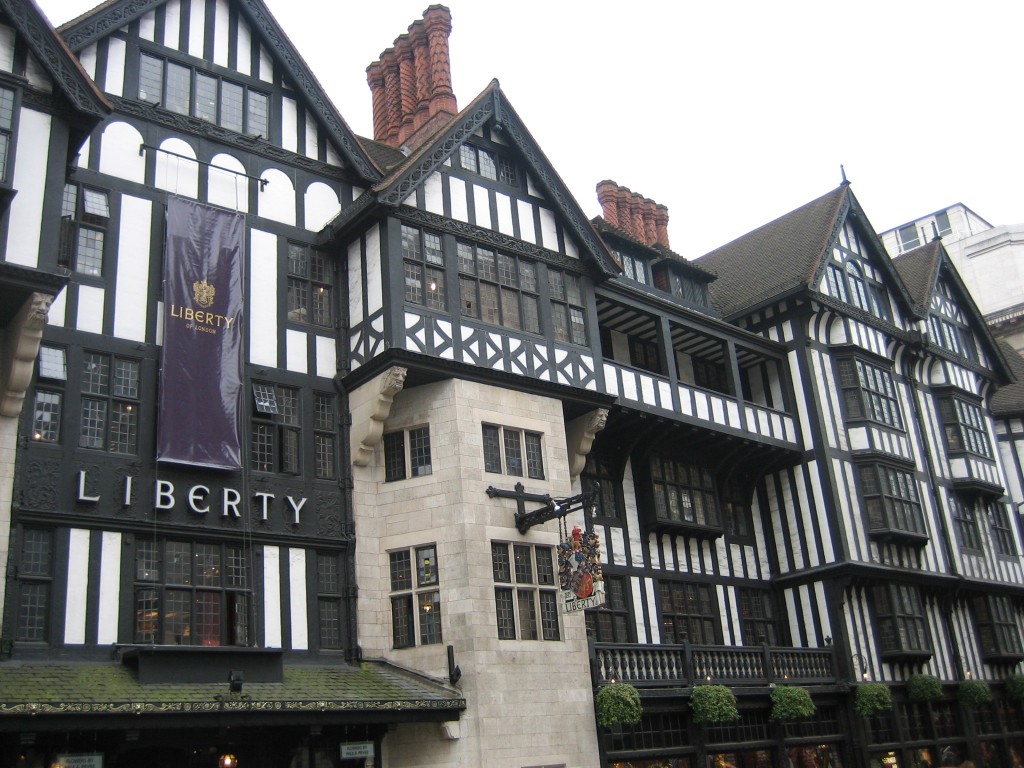
Did you know? Liberty was founded in 1875 by Arthur Liberty with a loan of £ 2000 – about £ 200,000 today – that he obtained from his ( future ) father-in-law; at the beginning the store was at 218a Regent Street and sold fabrics and art objects from the Far East. With the first earnings, Arthur Liberty bought the nearby shops and expanded his activity. The mock-Tudor building was built in the ’20s. The shop has become so synonymous with the Art Nouveau style , that in Italy the style itself is called “liberty”, from the name of the shop.
Now we go down to Kingley Street, passing under the arch, and we follow it to its end where it joins Beak Street. Turn right onto Upper James Street, pass Golden Square and continue to Brewer Street. Go straight to Sherwood Street passing under the arch. At the end of the road you will be back in Piccadilly Circus, where our walk ends.
Did you enjoy the walk? Share it with your friends and don’t forget to leave your comments.

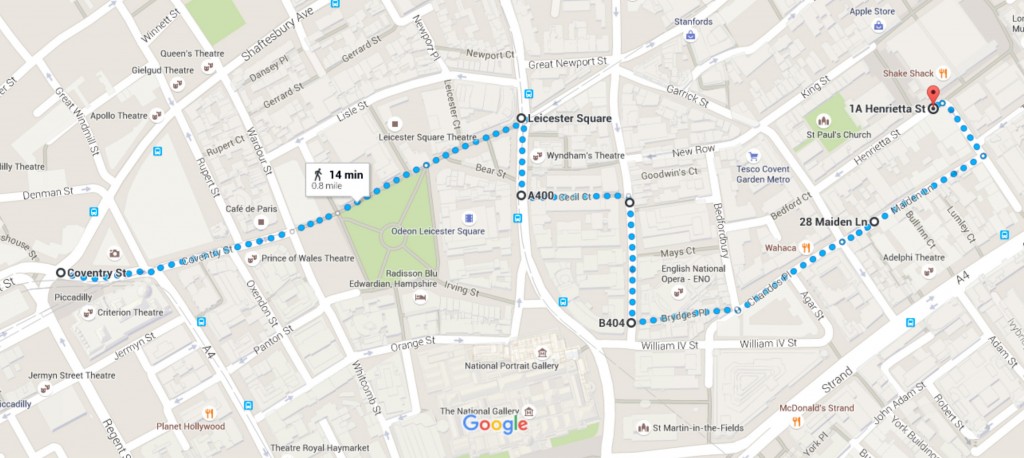

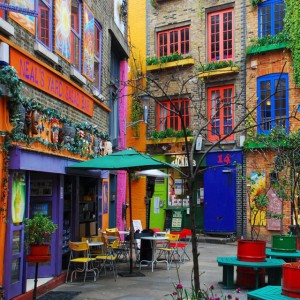
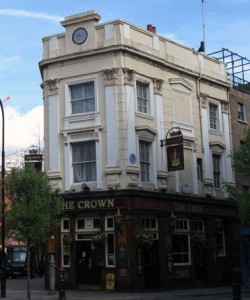

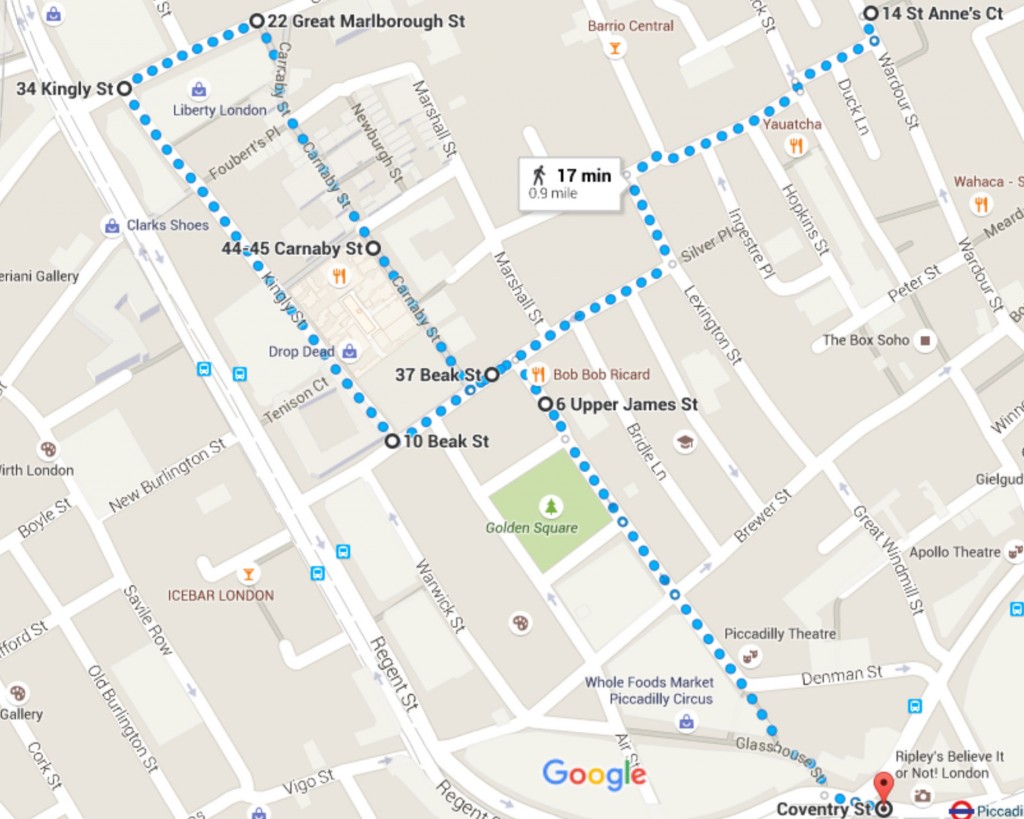
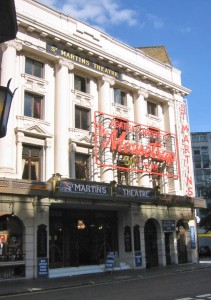


I stayed in London the summer of 71. Went to Piccadilly and its neigbourhood many nights, –
walked all the way back to Byng Place along Shaftesbury Avenue ant Tottenham Court Road.
It felt safe even at night. Love these areas! A London-fan ever since!!
Thanks!
Hi, many thanks for this walk. We used it October ’21 and found its clear instruction and interesting route commendable. Didn’t complete it all though. Got as far as the John Snow pub.
Maybe you could orient the maps so they all face north, and provide an overview map that shows the whole route. Cheers.
Hi Jim.
Glad you liked it. And thank you very much for your feedback!